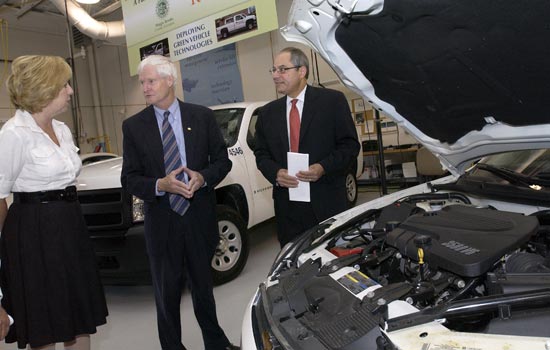RIT-county partnership results in alternative-energy vehicle study
A. Sue Weisler
RIT President Bill Destler, center, and Monroe County Executive Maggie Brooks join Nabil Nasr, assistant provost and director of RIT’s Center for Integrated Manufacturing Studies, to announce a new alternative-energy research partnership between the county and RIT on July 16. The project is part of the center’s Alternative Fuel and Life Cycle Engineering program, which is funded by the U.S. Department of Transportation.
RIT President Bill Destler and Nabil Nasr, assistant provost and director of the Center for Integrated Manufacturing Studies, joined County Executive Maggie Brooks July 16 to announce a new partnership between Monroe County and RIT to assess the performance of the county’s fleet of E85 flex-fuel vehicles. E85 is comprised of 85 percent ethanol and 15 percent gasoline and is considered a major alternative energy option for American automobiles.
The center will work with the county’s Department of Environmental Services to analyze the environmental and economic impact of these vehicles and assist the county in determining a future course for the integration of additional alternative energy technologies into its operations. “This cooperative public-private partnership will enhance RIT’s research program while providing Monroe County with valuable technical assistance and strategic planning information to further our efforts in utilizing alternative fuels,” notes Brooks. “Monroe County maintains a fleet of 78 hybrid-electric and E-85 flex-fuel vehicles. The research and information that will result from this partnership will enhance our efforts to protect our taxpayers and protect our environment.” “This partnership is a perfect example of how universities can utilize their technical expertise to assist government agencies in providing better services to their constituents while also helping to promote new industries,” adds Destler. “Alternative energy will be a major technology area in the coming years and CIMS’ efforts will help put Monroe County and RIT on the cutting edge of this important field.”
RIT’s work leverages a four-year, Department of Transportation grant that established CIMS’ Alternative Energy and Life Cycle Engineering Program in 2006. The grant was secured by U.S. Sens. Charles Schumer and Hillary Clinton. Along with its county partnership, CIMS is also working with RIT’s facilities management department to evaluate the effectiveness of their biodiesel vehicles, as well as the Rochester Genesee Regional Transit Authority to analyze the performance of their vehicle fleet and to study other alternative-fuel opportunities. Throughout the course of the research, the center will be performing a number of laboratory and field studies on the county’s “green fleet” to quantify the impact of these fuels on propulsion system durability, reliability, vehicle availability and life-cycle cost.
In addition, the center will be examining issues on expanding the available supply and application of these alternative fuels by studying infrastructure and supply chain. The center will also be looking to work with and support regional technology companies seeking to test, validate and launch their own innovative transportation products. Additionally, the RIT-Monroe County partnership will study the potential expansion of the E85 flex-fueled vehicle fleet, types of flex-fueled vehicles that meet county work requirements, methods to increase the amount of biodiesel used in county vehicles, storage considerations for alternative fuels, and the long-range outlook for fuel cells and hydrogen power. “We are very pleased to be collaborating with Monroe County to enhance our alternative fuel research,” notes Nasr. “This effort will assist in reducing the county’s reliance on fossil fuels, improve fuel efficiency and ultimately reduce costs to taxpayers. It’s a great example of how university-based research can support regional needs and economic growth. We also hope to use the data collected here to promote alternative energy implementation in additional public vehicle fleets throughout the country.”









